



A survey today of animation from the 1960’s into the mid 1980‘s, predating the cartoon Renaissance spawned by the premiere of Who Framed Roger Rabbit, which will be discussed next week. It was an uneven time, with some definite spans of meaningless fallow in which virtually all self-reference to cartoons being cartoons nearly disappeared. Yet, there were obviously some underlying seeds of discord among the staffs of various productions, who found some interesting ways to vent their frustrations at being unable to work with old-school characters of classic caliber, by creating opportunities to “homage” the works of the past masters in unexpected places. Furthermore, a few of the real old masters were still attempting to find work in the field of sporadic prime time specials, allowing for some new productions by Friz Freleng and Chuck Jones, nearly rivaling some of their classic work of the past.
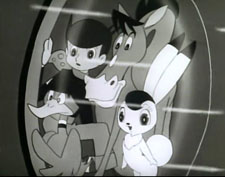 First, an extended look at an episode presenting an odd and unusual salute to Western animation from an unlikely vantage point – that of Japanese early anime. Osamu Tezuka’s Wonder 3 (aka The Amazing Three) contributes an episode translated as Beat Them With the Strange Machine (5/16/66). I am considerably hampered in review of this one, due to the American dub having not resurfaced since original domestic broadcast, and the considerably rare Japanese version having never been subcaptioned. Nevertheless, I will try to relate herein as much as I can discern from the substantial visual action. We are first introduced to a young man, apparently of wealth, with a supporting pair of cronies, at a private office. The young man appears cultured, and fancies himself a master at fencing. So much so, his office includes a full- size fake hobby horse for him to pretend to gallop on like a dashing musketeer, against a scrolling forest backdrop on rollers behind. For reasons unknown, he has it in for a more elderly rival industrialist (Perhaps a relative? His uncle or grandfather?), who seems to rule the town with industrial complexes built everywhere across it. Perhaps he envies the elder’s success compared to his own relative lack thereof. There seems also the possibility that he has some kind of a Greenpeace motive as well, and resents urban sprawl, as evidenced by his holding of a potted plant in an early shot.
First, an extended look at an episode presenting an odd and unusual salute to Western animation from an unlikely vantage point – that of Japanese early anime. Osamu Tezuka’s Wonder 3 (aka The Amazing Three) contributes an episode translated as Beat Them With the Strange Machine (5/16/66). I am considerably hampered in review of this one, due to the American dub having not resurfaced since original domestic broadcast, and the considerably rare Japanese version having never been subcaptioned. Nevertheless, I will try to relate herein as much as I can discern from the substantial visual action. We are first introduced to a young man, apparently of wealth, with a supporting pair of cronies, at a private office. The young man appears cultured, and fancies himself a master at fencing. So much so, his office includes a full- size fake hobby horse for him to pretend to gallop on like a dashing musketeer, against a scrolling forest backdrop on rollers behind. For reasons unknown, he has it in for a more elderly rival industrialist (Perhaps a relative? His uncle or grandfather?), who seems to rule the town with industrial complexes built everywhere across it. Perhaps he envies the elder’s success compared to his own relative lack thereof. There seems also the possibility that he has some kind of a Greenpeace motive as well, and resents urban sprawl, as evidenced by his holding of a potted plant in an early shot.
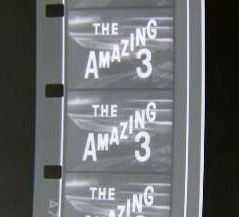 Anyway, our attention diverts to a meadow and forest area, where (we’ll use the character names from the American version) young Kenny Carter spends a relaxing afternoon with his three alien friends from outer space, each of whom has assumed the disguise of a typical Earth animal – Bonnie (a bunny), Ronnie (a horse and master inventor), and Zero (a duck, with a Beatle haircut). Kenny is reading a comic book (referred to as Manga in Japan. An interesting aspect of the concept of this series, which itself originated in Manga, is that Kenny’s older brother Randy, who is a professional secret agent, assumes the role of a Manga artist from time to time as his street-clothes “cover” identity.). Kenny is thoroughly enjoying the laughs he is getting from the comic stories, and Ronnie gets an idea to take them one better. Being limited to horse’s hooves has never served as an impediment to Ronnie’s inventing – nor does he ever seem to be in need of raw material to build from, always able to construct new objects out of nothing from nowhere. In a flurry of circular zigging and zagging, Ronnie materializes what looks a great deal like a barber’s chair, with two electrodes protruding at the top that flash with electrical bolts jumping in-between, a dashboard of switches and levers attached, and a large hole at the top for dropping in raw material for designs. Ronnie takes a comics page, inserts it in the machine’s hopper, and pulls some levers. The electricity sparks, and out of the beam materializes three-dimensional duplicates of the page’s characters, come to full life. The page is full of random, rather goofy-looking monsters, that seem to range from ghost-like blobs not far afield from designs for Pac-Man, to characters that seem to be half-marine animal, half-dinosaur. Kenny is amazed and delighted. He takes a whack at some on the monsters himself, bouncing atop the back of a sort of dinosaur-seal, getting briefly caught inside a transparent creature resembling a jellyfish, and rebounding off the side of the tough hide of a monster the size of a brontosaurus.
Anyway, our attention diverts to a meadow and forest area, where (we’ll use the character names from the American version) young Kenny Carter spends a relaxing afternoon with his three alien friends from outer space, each of whom has assumed the disguise of a typical Earth animal – Bonnie (a bunny), Ronnie (a horse and master inventor), and Zero (a duck, with a Beatle haircut). Kenny is reading a comic book (referred to as Manga in Japan. An interesting aspect of the concept of this series, which itself originated in Manga, is that Kenny’s older brother Randy, who is a professional secret agent, assumes the role of a Manga artist from time to time as his street-clothes “cover” identity.). Kenny is thoroughly enjoying the laughs he is getting from the comic stories, and Ronnie gets an idea to take them one better. Being limited to horse’s hooves has never served as an impediment to Ronnie’s inventing – nor does he ever seem to be in need of raw material to build from, always able to construct new objects out of nothing from nowhere. In a flurry of circular zigging and zagging, Ronnie materializes what looks a great deal like a barber’s chair, with two electrodes protruding at the top that flash with electrical bolts jumping in-between, a dashboard of switches and levers attached, and a large hole at the top for dropping in raw material for designs. Ronnie takes a comics page, inserts it in the machine’s hopper, and pulls some levers. The electricity sparks, and out of the beam materializes three-dimensional duplicates of the page’s characters, come to full life. The page is full of random, rather goofy-looking monsters, that seem to range from ghost-like blobs not far afield from designs for Pac-Man, to characters that seem to be half-marine animal, half-dinosaur. Kenny is amazed and delighted. He takes a whack at some on the monsters himself, bouncing atop the back of a sort of dinosaur-seal, getting briefly caught inside a transparent creature resembling a jellyfish, and rebounding off the side of the tough hide of a monster the size of a brontosaurus.
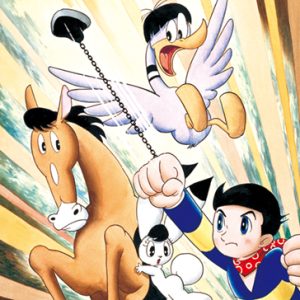 The monsters do not act aggressively, but are merely intimidating in their size and strangeness. Nevertheless, Kenny can tell he can’t challenge them single-handed. He grabs up the rest of his comic book, and decides he’ll also need some comic heroes. Ronnie begins to perspire, as realization sets in that his fun idea may be about to get out of hand, as Kenny throws the whole comic book into the invention’s hopper, and pulls a lever. Another electrical jolt, and an array of oddball, diminutive hero-types bursts into 3-D life. Many of these odd little characters roughly resemble imps one might have seen in random shots of “Porky in Wackyland”, but dressed in tiny crash helmets, space suits, and random odd garb. The little legion of do-gooders immediately start to do battle with the dino-monsters, two ganging up on one of the largest monsters, with one hero attempting to operate a jack-hammer into the dino’s back, while the other periodically leaps into the air to hit the beast on the nose with a club. Zero’s peaceful day is ruined when one of the imps mistakes him for a monster, jumping on his beak, then bopping him with a fist sock that briefly bends Zero’s bill. Zero takes after the imp with a cartoon mallet, performs the usual act of bashing himself on the noggin when the imp hides in his hair, then overshoots on the speed of his pursuit while the imp stands directly before the mouth of a sort of walrus-osaur. Zeto vanishes down the gullet of the monster, and is seen in x-ray cutaway inside, delivering punches to the walls of the beast’s digestive tube. The beast roars in pain, but ejects the stranger in an unexpected way – by laying an egg. Zero hatches from it, surrounded by a nest of other eggs, which all hatch into more imps to cause Zero more distress. Bonnie has by this time arrived on the scene, getting a brief chance to chastise Ronnie for his foolish invention, but quickly seeing things getting even more out of hand. Many of the characters are engaged in endless battle. Kenny is being pinned down by about six small female imps who seem to have a crush on him. Ronnie is being dragged away by several more heroes with a net. Even Bonnie herself is lifted off her feet by more imps. Zero has found his mallet again, and takes a whirling swing at the egg hatchlings, but has the mallet head detach from the handle, somehow take a whirling u-turn, and smack a blow to the side of Zero’s head, knocking the duck straight into the side of Ronnie’s machine. The machine is jarred by vibration, the electrodes come to life once again, and with a sort of electronic moaning sound, all the creatures created by the machine fade from existence, restoring the meadow to its original peace and tranquility.
The monsters do not act aggressively, but are merely intimidating in their size and strangeness. Nevertheless, Kenny can tell he can’t challenge them single-handed. He grabs up the rest of his comic book, and decides he’ll also need some comic heroes. Ronnie begins to perspire, as realization sets in that his fun idea may be about to get out of hand, as Kenny throws the whole comic book into the invention’s hopper, and pulls a lever. Another electrical jolt, and an array of oddball, diminutive hero-types bursts into 3-D life. Many of these odd little characters roughly resemble imps one might have seen in random shots of “Porky in Wackyland”, but dressed in tiny crash helmets, space suits, and random odd garb. The little legion of do-gooders immediately start to do battle with the dino-monsters, two ganging up on one of the largest monsters, with one hero attempting to operate a jack-hammer into the dino’s back, while the other periodically leaps into the air to hit the beast on the nose with a club. Zero’s peaceful day is ruined when one of the imps mistakes him for a monster, jumping on his beak, then bopping him with a fist sock that briefly bends Zero’s bill. Zero takes after the imp with a cartoon mallet, performs the usual act of bashing himself on the noggin when the imp hides in his hair, then overshoots on the speed of his pursuit while the imp stands directly before the mouth of a sort of walrus-osaur. Zeto vanishes down the gullet of the monster, and is seen in x-ray cutaway inside, delivering punches to the walls of the beast’s digestive tube. The beast roars in pain, but ejects the stranger in an unexpected way – by laying an egg. Zero hatches from it, surrounded by a nest of other eggs, which all hatch into more imps to cause Zero more distress. Bonnie has by this time arrived on the scene, getting a brief chance to chastise Ronnie for his foolish invention, but quickly seeing things getting even more out of hand. Many of the characters are engaged in endless battle. Kenny is being pinned down by about six small female imps who seem to have a crush on him. Ronnie is being dragged away by several more heroes with a net. Even Bonnie herself is lifted off her feet by more imps. Zero has found his mallet again, and takes a whirling swing at the egg hatchlings, but has the mallet head detach from the handle, somehow take a whirling u-turn, and smack a blow to the side of Zero’s head, knocking the duck straight into the side of Ronnie’s machine. The machine is jarred by vibration, the electrodes come to life once again, and with a sort of electronic moaning sound, all the creatures created by the machine fade from existence, restoring the meadow to its original peace and tranquility.
While Kenny and the Wonder 3 try to get their heads together and recover from the trauma of what has occurred, two sets of eyes peer from around a tree at a distance. The two henchmen of the young man we met in the opening have been watching the events in the woods, and have seen the whole marvelous affair. Tunneling underground into the midst of our heroes, the two henchmen toss out into the field a smoke gas bomb, which knocks out our heroes temporarily. When the smoke clears and out heroes lay prone, the henchmen try theor own hand at operating the machine. The shorter, fatter henchmen is passed a piece of paper by the other, and told to draw something. He complies, tossing his drawing into the hopper, and pulls the lever. Out pops a cornucopia of foodstuffs, from which he starts partaking his fill. The taller henchman bops him on the head for bringing to reality such a useless thought, and whips out a sheet of paper himself, drawing a rickety wooden framework of a makeshift plane. His drawing soon pops to life, providing a means of transporting themselves and the machine back to the boss (though the poor design at first results in the plane’s frame collapsing under the weight of the machine, requiring a lot of Scotch tape to ultimately patch things up). The villains take off with their prize, just as Bonnie and some of the others begin to come to. Bonnie panics at the sight of the plane getting away, but all is not entirely lost, as the head of Zero is seen amidst the tail assembly, the duck having already revived and riding along as a stowaway.
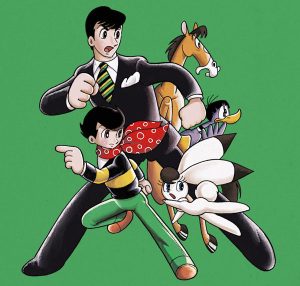 The tall henchman also did not fully calculate how much gasoline to draw into the plane’s gas tank – resulting in an unexpected crash landing through the roof of the young man’s office. The boss is at first appalled at the mess, until the henchmen start to describe the machine and what they have seen it do. The tall henchmen asks the fat one to push the lever for a demonstration, but unfortunately gets only a repeat of the sea of foodstuffs previously drawn by the fat one, all over the boss’s floor. Zero doesn’t miss an opportunity, leaping out of hiding to devour himself a quick lunch. The boss tells the henchmen to get rid of the duck, but after the three disappear into a fight cloud, the henchmen lie in a heap, with Zero brushing off the dust, unscathed. However, Zero’s fighting moves are no match for the boss’s swordsmanship, and Zero is shorn of feathers, first seen briefly in polka-dot shorts, and then ready for basting in the oven. The henchmen lay into him again, and soon have him tied up and locked in a cage. They then proceed further with the demonstration, the tall henchman drawing for the boss a realistic horse which can serve as an impressive steed to march into battle with, in place of the boss’s dream hobby-horse. The boss is impressed when the steed springs to life from the machine, and more so when the henchmen insert a new drawing into the hopper, and begin churning out an army of half-sized miniature tanks. At the head of the armada, the boss orders a charge, and begins parading his army slowly in the direction of his rival industrialist. As the troops begin to leave the building. Zero revives, becomes cognizant of the plan, and manages to slip through the bars of the cage, slithering in snake-like fashion. Through some kind of interface with a TV monitor and transmitter in an adjacent room, he is able to broadcast a distress call by pecking with his bill, quickly picked up by Bonnie at W3 headquarters. The good guys are on their way in Ronnie’s master mode of transportation, The Big Wheel (a giant tire with a glass passenger bubble mounted within its center), to see what they can do.
The tall henchman also did not fully calculate how much gasoline to draw into the plane’s gas tank – resulting in an unexpected crash landing through the roof of the young man’s office. The boss is at first appalled at the mess, until the henchmen start to describe the machine and what they have seen it do. The tall henchmen asks the fat one to push the lever for a demonstration, but unfortunately gets only a repeat of the sea of foodstuffs previously drawn by the fat one, all over the boss’s floor. Zero doesn’t miss an opportunity, leaping out of hiding to devour himself a quick lunch. The boss tells the henchmen to get rid of the duck, but after the three disappear into a fight cloud, the henchmen lie in a heap, with Zero brushing off the dust, unscathed. However, Zero’s fighting moves are no match for the boss’s swordsmanship, and Zero is shorn of feathers, first seen briefly in polka-dot shorts, and then ready for basting in the oven. The henchmen lay into him again, and soon have him tied up and locked in a cage. They then proceed further with the demonstration, the tall henchman drawing for the boss a realistic horse which can serve as an impressive steed to march into battle with, in place of the boss’s dream hobby-horse. The boss is impressed when the steed springs to life from the machine, and more so when the henchmen insert a new drawing into the hopper, and begin churning out an army of half-sized miniature tanks. At the head of the armada, the boss orders a charge, and begins parading his army slowly in the direction of his rival industrialist. As the troops begin to leave the building. Zero revives, becomes cognizant of the plan, and manages to slip through the bars of the cage, slithering in snake-like fashion. Through some kind of interface with a TV monitor and transmitter in an adjacent room, he is able to broadcast a distress call by pecking with his bill, quickly picked up by Bonnie at W3 headquarters. The good guys are on their way in Ronnie’s master mode of transportation, The Big Wheel (a giant tire with a glass passenger bubble mounted within its center), to see what they can do.
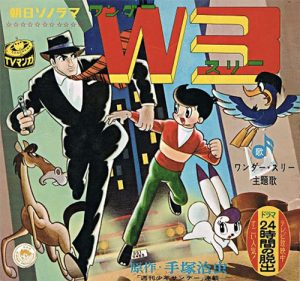 The tanks continue to pour out of the young man’s office. Some of the last ones include an additional modification to the design, adding missile launchers. They approach the main house of the industrialist’s complex. The industrialist seems not at all surprised at the thought that the young man would mount an offensive against him, and is himself prepared with his own array of defensive cannon and machine gun mountings within the walls of the estate. The young man calls a challenge to the industrialist, but merely receives a warning cannon blast in return that knocks him off his horse. The young man gives order to open fire. His tanks fire two volleys of shots. But toon tanks don’t seem to work nearly as well as real ones, instead acting in a more comic way – such that all of the tank shells merely fall to the ground short of their target, landing in the dirt like so many worthless cocoanuts. The young man angrily kicks at one of them – and only then does the shell explode, blowing up in his face. The industrialist retaliates with machine gun fire, blasting away several of the tanks from the young man’s front line. The young man pulls back into his ranks, firing a heretofore unseen larger cannon on a wheeled base. The shot sails high into the air, but again begins to drop far short of its intended mark. Knowing this isn’t good, the young man races forward in panicked gait, attempting to keep underneath the cannon shell and blowing with all his lung power skyward, to prevent the shell from coming down too soon. This can’t last forever, and the ball finally drops – on the young man’s head. He returns to the cannon, and fires a second shot – but the ball barely escapes the cannon’s mouth, flips backward atop the barrel, and rolls down the inclined barrel, to land on the young man once again. The young man pulls out his sword, angrily jabbing at the cannon – and punctures it, deflating its mounting and barrel like a sagging balloon, and causing the last cannonball to roll out of the drooping barrel onto the ground, then disintegrate into powder. The industrialist and his supporters laugh uproariously at the young man from the safety of their fortifications. The young man fires his missile launchers, but the industrialist also fires an anti-missile missile. The young man’s missiles develop faces and cowardice, and turn tail to retreat with the yips of two terrified dogs. Down to himself and his two henchmen, the young man and henchmen charge the compound with mere swords – but are soon beating a retreat, with guard dogs chomping on the seats of their trousers.
The tanks continue to pour out of the young man’s office. Some of the last ones include an additional modification to the design, adding missile launchers. They approach the main house of the industrialist’s complex. The industrialist seems not at all surprised at the thought that the young man would mount an offensive against him, and is himself prepared with his own array of defensive cannon and machine gun mountings within the walls of the estate. The young man calls a challenge to the industrialist, but merely receives a warning cannon blast in return that knocks him off his horse. The young man gives order to open fire. His tanks fire two volleys of shots. But toon tanks don’t seem to work nearly as well as real ones, instead acting in a more comic way – such that all of the tank shells merely fall to the ground short of their target, landing in the dirt like so many worthless cocoanuts. The young man angrily kicks at one of them – and only then does the shell explode, blowing up in his face. The industrialist retaliates with machine gun fire, blasting away several of the tanks from the young man’s front line. The young man pulls back into his ranks, firing a heretofore unseen larger cannon on a wheeled base. The shot sails high into the air, but again begins to drop far short of its intended mark. Knowing this isn’t good, the young man races forward in panicked gait, attempting to keep underneath the cannon shell and blowing with all his lung power skyward, to prevent the shell from coming down too soon. This can’t last forever, and the ball finally drops – on the young man’s head. He returns to the cannon, and fires a second shot – but the ball barely escapes the cannon’s mouth, flips backward atop the barrel, and rolls down the inclined barrel, to land on the young man once again. The young man pulls out his sword, angrily jabbing at the cannon – and punctures it, deflating its mounting and barrel like a sagging balloon, and causing the last cannonball to roll out of the drooping barrel onto the ground, then disintegrate into powder. The industrialist and his supporters laugh uproariously at the young man from the safety of their fortifications. The young man fires his missile launchers, but the industrialist also fires an anti-missile missile. The young man’s missiles develop faces and cowardice, and turn tail to retreat with the yips of two terrified dogs. Down to himself and his two henchmen, the young man and henchmen charge the compound with mere swords – but are soon beating a retreat, with guard dogs chomping on the seats of their trousers.
The young man, with X’s of hatred in his eyes instead of irises, finally gets an inspiration. Real-life weapons don’t work from the machine, as they react with toony behavior. So what about using something that works in a toon world? Actual toons. He quickly begins drawing on several sheets of paper monsters that closely resemble the ones from Kenny’s comic book. The industrialist’s defenses, not prepared to withstand such a strange attack, are no match for the onslaught, and soon the bizarre creatures are doing their best impression of a Godzilla feature, scaling and eating the structures of the industrialist’s development. Bullets and cannonfire merely bounce off their chests, or make the creatures giggle from being ticklish. One monster breaks off a smokestack from a factory, smoking it like a cigar, then dumps out the ashes by tapping it on the roof of a large gas-house – igniting the industrialist’s complex into flames. The young man is overjoyed at the devastation – but non-plussed when he discovers the monsters aren’t particular, and begin to dismantle his own office and domicile too. Amidst the rubble, Zero is freed from his bonds. He attempts a one-duck attack against the beasts, but is flicked around like a fly, then smashed flat between the flippers of one of the beasts with the sound-effect of a cymbal crash. Kenny, Bonnie and Ronnie finally arrive amidst the debris field, and are reunited with Zero, who fills them in. Despite the young man’s own properties laying in waste, the young man is ready to declare a victory over his rival, raising his sword high as a sign of his valor – but has his moment of glory rained upon when our heroes are spotted, clustered around Ronnie’s invention. Kenny is armed with drawing paper, and begins to generate a series of imps like the ones seen earlier, to send out against the monsters.
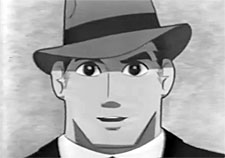 One pipsqueak bats with a small club upon one of the giants’ toenails, and gets stomped into the ground. However, from the hole made in the earth directly below the monster’s foot, the imp produces a feather, and begins vigorously tickling the sole of the monster. The creature giggles and rolls uncontrollably, then literally laughs itself to death, dissolving into a clump of fresh green trees. The imp, its work done, also dissolves from existence, transforming into a flower. Similar imps are prpduced by Kenny, a first of which demonstrates the skills of Droopy when made mad, repeatedly judo-flipping a monster by its lobster-claw until it too fades from existence into more teees. A single blow into the belly-button of a third monster by an imp results in said monster’s same fate. The young man again resorts to his sword, challenging Kenny one-on-one. Kenny produces a sword of his own with a drawing, but proves no match for the young man’s fancy swordplay, and is quickly disarmed. Bonnie hurriedly hands Ronnie another drawing, of one who can stand his own against even this young man’s best fencing – D’Artagnan from the Three Musketeers. In a twinkling, the legendary swordsman is there in the flesh. The young man finally finds himself out-dueled, his sword being knocked away to one side. Well, a sword never stood up well against a good old pistol anyway – so the young man reaches into his vest picket and produces a firearm. Kenny can only wish his secret-agent brother Randy was here – but he for once is awat in another part of the world on assignment. However, Kenny just happens to keep a photo of his brother in his pocket. So if we toss it into the machine – out comes a life-like duplicate of Randy, with all his skills. A brief gunfight ensues, and a well-placed shot by duplicate-Randy shatters a tree limb from which the young man is dangling, dousing him well into a stream below. The young man has had it, and briefly lays exhausted. He rises to moan that he has lost everything, but Kenny points around them to the peaceful world of forest and field that has somehow sprung up out of the debris from all the creatures of the machine, now in evaporated form. The young man is approached by the industrialist, who also has lost everything, but also takes note of the peaceful countryside that has emerged around them. The two exchange unknown words, but appear to reach some point of reconciliation, realizing that perhaps neither was right, and they should work together to make a better world. The episode ends on a happy note, as Kenny and the three head home in the Big Wheel, Zero making some closing sarcastic remark about the whole affair, probably in vainglorious Daffy Duck-style about not getting enough credit for his part in saving the day. An exceptional example of East meeting West, and a rare instance of a usually dramatic anime show making way for an episode of nearly pure comedy.
One pipsqueak bats with a small club upon one of the giants’ toenails, and gets stomped into the ground. However, from the hole made in the earth directly below the monster’s foot, the imp produces a feather, and begins vigorously tickling the sole of the monster. The creature giggles and rolls uncontrollably, then literally laughs itself to death, dissolving into a clump of fresh green trees. The imp, its work done, also dissolves from existence, transforming into a flower. Similar imps are prpduced by Kenny, a first of which demonstrates the skills of Droopy when made mad, repeatedly judo-flipping a monster by its lobster-claw until it too fades from existence into more teees. A single blow into the belly-button of a third monster by an imp results in said monster’s same fate. The young man again resorts to his sword, challenging Kenny one-on-one. Kenny produces a sword of his own with a drawing, but proves no match for the young man’s fancy swordplay, and is quickly disarmed. Bonnie hurriedly hands Ronnie another drawing, of one who can stand his own against even this young man’s best fencing – D’Artagnan from the Three Musketeers. In a twinkling, the legendary swordsman is there in the flesh. The young man finally finds himself out-dueled, his sword being knocked away to one side. Well, a sword never stood up well against a good old pistol anyway – so the young man reaches into his vest picket and produces a firearm. Kenny can only wish his secret-agent brother Randy was here – but he for once is awat in another part of the world on assignment. However, Kenny just happens to keep a photo of his brother in his pocket. So if we toss it into the machine – out comes a life-like duplicate of Randy, with all his skills. A brief gunfight ensues, and a well-placed shot by duplicate-Randy shatters a tree limb from which the young man is dangling, dousing him well into a stream below. The young man has had it, and briefly lays exhausted. He rises to moan that he has lost everything, but Kenny points around them to the peaceful world of forest and field that has somehow sprung up out of the debris from all the creatures of the machine, now in evaporated form. The young man is approached by the industrialist, who also has lost everything, but also takes note of the peaceful countryside that has emerged around them. The two exchange unknown words, but appear to reach some point of reconciliation, realizing that perhaps neither was right, and they should work together to make a better world. The episode ends on a happy note, as Kenny and the three head home in the Big Wheel, Zero making some closing sarcastic remark about the whole affair, probably in vainglorious Daffy Duck-style about not getting enough credit for his part in saving the day. An exceptional example of East meeting West, and a rare instance of a usually dramatic anime show making way for an episode of nearly pure comedy.
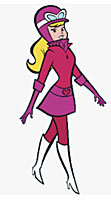 A brief mention is deserved for Hanna-Barbera’s, The Perils of Penelope Pitstop (1969), one of two sequels to the successful “Wacky Races” produced that year. Patterned as an endless string of cliff-hanging peril, lampooning the old movie serials such as “The Perils of Pauline”, the series pitted Penelope and her ever-vigilant protectors, The Ant Hill Mob (trying to be the seven dwarfs) against the sinister Sylvester Sneakley, Penelope’s guardian and next-in-line to inherit the Pitstop fortune, who masquerades throughout the series as the devilish Hooded Claw. The series’ high-concept was never truly lived up to, and the use of perils one after the other, week after week, failed to build the necessary elements of suspense and true concern for the welfare of the characters, which might have actually been improved had the series truly broken into chapter form to allow viewers time to ponder what might happen next. The series’ one strong point deserving mention for this article was its heavy use of narration provided by Gary Owens, who would often break the fourth wall to make inquiries of the characters or somehow get a level of personal involvement in the plot, with both the Claw (Paul Lynde) and Penelope (Janet Waldo) often responding back to the narrator directly in conversational fashion regarding their insights and points of view upon the story line. One line from an episode I have not taken the time to specifically identify was notable in this regard between the Claw and Mr. Owens. One of the latest schemes of the Claw has as usual been interfered with and crossed-up by the do-gooders, to which Lynde snidely remarks, “I protest.” In a timely comment upon pop-culture and protest marches common to the late ‘60’s, Gary Owens responds. “Why not? Everyone else is.”
A brief mention is deserved for Hanna-Barbera’s, The Perils of Penelope Pitstop (1969), one of two sequels to the successful “Wacky Races” produced that year. Patterned as an endless string of cliff-hanging peril, lampooning the old movie serials such as “The Perils of Pauline”, the series pitted Penelope and her ever-vigilant protectors, The Ant Hill Mob (trying to be the seven dwarfs) against the sinister Sylvester Sneakley, Penelope’s guardian and next-in-line to inherit the Pitstop fortune, who masquerades throughout the series as the devilish Hooded Claw. The series’ high-concept was never truly lived up to, and the use of perils one after the other, week after week, failed to build the necessary elements of suspense and true concern for the welfare of the characters, which might have actually been improved had the series truly broken into chapter form to allow viewers time to ponder what might happen next. The series’ one strong point deserving mention for this article was its heavy use of narration provided by Gary Owens, who would often break the fourth wall to make inquiries of the characters or somehow get a level of personal involvement in the plot, with both the Claw (Paul Lynde) and Penelope (Janet Waldo) often responding back to the narrator directly in conversational fashion regarding their insights and points of view upon the story line. One line from an episode I have not taken the time to specifically identify was notable in this regard between the Claw and Mr. Owens. One of the latest schemes of the Claw has as usual been interfered with and crossed-up by the do-gooders, to which Lynde snidely remarks, “I protest.” In a timely comment upon pop-culture and protest marches common to the late ‘60’s, Gary Owens responds. “Why not? Everyone else is.”
 An article last week has already pointed out The Daffy Duck Easter Show (1980), which featured interstitial segments I’d long forgotten, giving Daffy the artist’s brush treatment he previously received in Duck Amuck with new outcomes. The reader is directed to such article for a complete rundown on the special, and full video of same to boot. Also produced this same year was Bugs Bunny’s Bustin’ Out All Over, a summertime special directed by Chuck Jones, which featured the new short, Portrait Of the Artist As a Young Bunny. It is a typical Bugs and Elmer script, returning to an idea used for half of Bob Clampett’s The Old Gray Hare, with the characters allegedly having their first meeting as juveniles. Animation is not bad by a longshot, and presents a few creative twists on old situations. One particular gag from this episode decidedly fits into our subject of cartoon consciousness. Junior Elmer has faced off against Bugs with a giant popgun cannon. As the cork fires, Bugs leaps astride it, riding it like a mount, and steering it into a curve back in the direction of Elmer while uttering cowboy yells. Elmer is chased by the cork off the edge of cliff, but remains standing in mid-air. Bugs calls to him from the cliff edge. “Hey Doc! You got a problem. Gravity.” Elmer brushes off the warning. “Oh, that’s all wight. We haven’t studied gwavity yet”, and proceeds to calmly walk forward on air to the opposite cliff. A dissolve to a scene ahead of Elmer, where Bugs sets out a textbook in plain sight for Elmer to see beneath a tree. It is entitled, “Gravity For Beginners, by I.Q. Lowe. Elmer happens across the book, picks it up, and begins to read. Learning gravity is the force that causes something to fall when it is dropped, Elmer wonders if that will work now if he ever is dropped. He has not long to find out, as he has again walked off a cliff while reading through the pages. Before taking the plunge, Elmer utters the conclusion that “Ignowance is the best policy.” He begins a fall into a traditional Jones’ style canyon. So traditional, in fact, that Elmer is tapped on the shoulder by a furry hand while only part-way through the fall. Above him is none other than Wile E. Coyote, who holds out a sign to him, reading, “Move over, Buster, and let someone fall who knows how.”
An article last week has already pointed out The Daffy Duck Easter Show (1980), which featured interstitial segments I’d long forgotten, giving Daffy the artist’s brush treatment he previously received in Duck Amuck with new outcomes. The reader is directed to such article for a complete rundown on the special, and full video of same to boot. Also produced this same year was Bugs Bunny’s Bustin’ Out All Over, a summertime special directed by Chuck Jones, which featured the new short, Portrait Of the Artist As a Young Bunny. It is a typical Bugs and Elmer script, returning to an idea used for half of Bob Clampett’s The Old Gray Hare, with the characters allegedly having their first meeting as juveniles. Animation is not bad by a longshot, and presents a few creative twists on old situations. One particular gag from this episode decidedly fits into our subject of cartoon consciousness. Junior Elmer has faced off against Bugs with a giant popgun cannon. As the cork fires, Bugs leaps astride it, riding it like a mount, and steering it into a curve back in the direction of Elmer while uttering cowboy yells. Elmer is chased by the cork off the edge of cliff, but remains standing in mid-air. Bugs calls to him from the cliff edge. “Hey Doc! You got a problem. Gravity.” Elmer brushes off the warning. “Oh, that’s all wight. We haven’t studied gwavity yet”, and proceeds to calmly walk forward on air to the opposite cliff. A dissolve to a scene ahead of Elmer, where Bugs sets out a textbook in plain sight for Elmer to see beneath a tree. It is entitled, “Gravity For Beginners, by I.Q. Lowe. Elmer happens across the book, picks it up, and begins to read. Learning gravity is the force that causes something to fall when it is dropped, Elmer wonders if that will work now if he ever is dropped. He has not long to find out, as he has again walked off a cliff while reading through the pages. Before taking the plunge, Elmer utters the conclusion that “Ignowance is the best policy.” He begins a fall into a traditional Jones’ style canyon. So traditional, in fact, that Elmer is tapped on the shoulder by a furry hand while only part-way through the fall. Above him is none other than Wile E. Coyote, who holds out a sign to him, reading, “Move over, Buster, and let someone fall who knows how.”
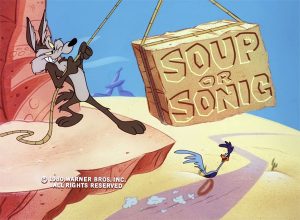 In the same special appeared what would be Jones’s last Road Runner short for a good many years to come, Soup or Sonic. It is a very traditional entry in the long run of the series, quite fully animated, delightfully-timed, and with an unusual surprise ending. It makes good use of Wile E.’s trademark sign gags, first with a running gag of a quartet of ways of how not to launch a passenger skyrocket at the road-runner from an opposite cliff. Three such efforts result in plunges into the same old canyon, but the final attempt finally gets the rocket lit and launched (after also igniting Wile E.’s tail). Unfortunately, after all that effort, Wile E.’s trajectory is measured too low, and he disappears into a crater in the canyon wall below the ledge, then is blasted out of the hole in charred form as the rocket explodes. Before falling again, Wile E. holds up a sign to the audience reading, “How did I ever get into this line of work?” Next, a sequence with a 12-pack of Acme exploding tennis balls, guaranteed to explode on contact when they hit a solid object. A practice smash from Wile E.’s racquet easily takes out a giant cactus. As the road-runner approaches, the coyote takes aim at him with another smash. His shot misses, somehow taking a bounce off the pavement in front of the road-runner without exploding. The shot is returned when it hits the springy arm of another cactus. Wile E. backs up to return the shot, but again has the ball returned to him by rebounding off an equally-springy telephone wire. Wile E. finds himself in a real match to keep the ball from hitting anything solid, and eventually cannot back up fast enough to prevent the ball from landing – where else – right back in the package of the one-dozen balls minus one. Wile E. skids to a stop before the camera, and just before the explosion, has only time to twitch his eyes in apprehension, and hold up two signs to the audience. “For sale: one used tennis racquet.” “Cheap.” The final sequence has the road-runner disappear into the open end of a long stretch of water pipe resting on the side of the road, with the coyote following him inside. The large open pipe connects at its other end to a more narrow extension of pipe, then a narrower one, then more narrow still, until the output at the other end has a diameter of only about two inches wide. Both the Road-runner and Coyote emerge from the pipe, the size of mice. Wile E. notices something wrong, as he passes a cigar butt left behind by some workman, which dwarfs him in height. He whistles to the road-runner ahead, and gestures to him to reverse and go back the other way, the coyote allowing the road- runner to pass him in sportsmanlike fashion to re-enter the narrow end of the pipe. They both proceed back through the pipeline, and emerge out the wide end. The road-runner is restored to original size. But for reasons unknown, Wile E. emerges, still at mouse size. The road-runner turns, observing this odd twist of fate, and stops dead in his tracks, allowing the coyote to catch up with him. Continuing to run at full throttle, and unaware of what is going on, the coyote nearly trips over the claws of the road-runner’s feet, then puts on the brakes when he realizes what he stumbled over. In amazed happiness, he dashes back, and clutches victoriously to the road-runner’s ankles. Reflexively, he ties on a bib and produces a knife and fork, but before he can open his jaws for a bite, reality sets in, as he turns his head upwards to see the unusual point of view. The body of the road-runner towers above him, and the bird bends his head far down to look the coyote dead in the eye, and utter a “Beep Beep” that sounds so deeply-pitched as to be coming from a Mack truck. In a final close up, the shocked Wile E. turns his gaze to the camera, as a perturbed expression crosses his face. He holds up a final two signs to the audience to express his dismaying problem. “Okay, wise guys. You always wanted me to catch him.” “NOW what do I do?”
In the same special appeared what would be Jones’s last Road Runner short for a good many years to come, Soup or Sonic. It is a very traditional entry in the long run of the series, quite fully animated, delightfully-timed, and with an unusual surprise ending. It makes good use of Wile E.’s trademark sign gags, first with a running gag of a quartet of ways of how not to launch a passenger skyrocket at the road-runner from an opposite cliff. Three such efforts result in plunges into the same old canyon, but the final attempt finally gets the rocket lit and launched (after also igniting Wile E.’s tail). Unfortunately, after all that effort, Wile E.’s trajectory is measured too low, and he disappears into a crater in the canyon wall below the ledge, then is blasted out of the hole in charred form as the rocket explodes. Before falling again, Wile E. holds up a sign to the audience reading, “How did I ever get into this line of work?” Next, a sequence with a 12-pack of Acme exploding tennis balls, guaranteed to explode on contact when they hit a solid object. A practice smash from Wile E.’s racquet easily takes out a giant cactus. As the road-runner approaches, the coyote takes aim at him with another smash. His shot misses, somehow taking a bounce off the pavement in front of the road-runner without exploding. The shot is returned when it hits the springy arm of another cactus. Wile E. backs up to return the shot, but again has the ball returned to him by rebounding off an equally-springy telephone wire. Wile E. finds himself in a real match to keep the ball from hitting anything solid, and eventually cannot back up fast enough to prevent the ball from landing – where else – right back in the package of the one-dozen balls minus one. Wile E. skids to a stop before the camera, and just before the explosion, has only time to twitch his eyes in apprehension, and hold up two signs to the audience. “For sale: one used tennis racquet.” “Cheap.” The final sequence has the road-runner disappear into the open end of a long stretch of water pipe resting on the side of the road, with the coyote following him inside. The large open pipe connects at its other end to a more narrow extension of pipe, then a narrower one, then more narrow still, until the output at the other end has a diameter of only about two inches wide. Both the Road-runner and Coyote emerge from the pipe, the size of mice. Wile E. notices something wrong, as he passes a cigar butt left behind by some workman, which dwarfs him in height. He whistles to the road-runner ahead, and gestures to him to reverse and go back the other way, the coyote allowing the road- runner to pass him in sportsmanlike fashion to re-enter the narrow end of the pipe. They both proceed back through the pipeline, and emerge out the wide end. The road-runner is restored to original size. But for reasons unknown, Wile E. emerges, still at mouse size. The road-runner turns, observing this odd twist of fate, and stops dead in his tracks, allowing the coyote to catch up with him. Continuing to run at full throttle, and unaware of what is going on, the coyote nearly trips over the claws of the road-runner’s feet, then puts on the brakes when he realizes what he stumbled over. In amazed happiness, he dashes back, and clutches victoriously to the road-runner’s ankles. Reflexively, he ties on a bib and produces a knife and fork, but before he can open his jaws for a bite, reality sets in, as he turns his head upwards to see the unusual point of view. The body of the road-runner towers above him, and the bird bends his head far down to look the coyote dead in the eye, and utter a “Beep Beep” that sounds so deeply-pitched as to be coming from a Mack truck. In a final close up, the shocked Wile E. turns his gaze to the camera, as a perturbed expression crosses his face. He holds up a final two signs to the audience to express his dismaying problem. “Okay, wise guys. You always wanted me to catch him.” “NOW what do I do?”
• A great print of “Soup or Sonic” is on Toontales.net.
 Who’re You Calling Two-Dimensional? (DIC, The Real Ghostbusters, 12/24/87) – Not much about this episode makes sense – including why it is an entry in this particular series at all, considering there is no actual ghost found in the entire episode, so that the Ghostbusters might as well have been called out on a false alarm. Still, the episode is an amusing entertainment, and a must-mention for this article series. The Ghostbuster crew is called to visit the site of the now-defunct original Walt Fleischman animation studio, closed for 40 tears. An elderly female caretaker of the place where animation history was made has certainly waited a long-enough time to seek an inspection by qualified personnel of the private office where Fleischman worked for years in creating life-like master animation years ahead of its time and never equaled, recalling strange screams and sounds within the office on the night that Fleischman disappeared 40 years ago, never to be seen again. Dod she just hear about the Ghostbusters’ service, to be bringing this to their attention now for the first time? (A question never answered.) The boys scan the room with their hi-tech gadgets, finding nothing of ectoplasm. However, for reasons never disclosed, a magic doorway appears in a wall behind one of them. Investigative stupidity being a professional trait of Ghostbusters, they of course open the door – and are immediately sucked into a dimensional portal, the door closing behind them and disappearing from existence. (Why would the door appear after all these years at this precise time? Not being made of ectoplasm, it should have no reactivity to the Ghostbusters’ gadgets. If someone behind it is just trying to keep any nosy investigators from getting in the way, then why didn’t it ever appear for the snoopy caretaker?)
Who’re You Calling Two-Dimensional? (DIC, The Real Ghostbusters, 12/24/87) – Not much about this episode makes sense – including why it is an entry in this particular series at all, considering there is no actual ghost found in the entire episode, so that the Ghostbusters might as well have been called out on a false alarm. Still, the episode is an amusing entertainment, and a must-mention for this article series. The Ghostbuster crew is called to visit the site of the now-defunct original Walt Fleischman animation studio, closed for 40 tears. An elderly female caretaker of the place where animation history was made has certainly waited a long-enough time to seek an inspection by qualified personnel of the private office where Fleischman worked for years in creating life-like master animation years ahead of its time and never equaled, recalling strange screams and sounds within the office on the night that Fleischman disappeared 40 years ago, never to be seen again. Dod she just hear about the Ghostbusters’ service, to be bringing this to their attention now for the first time? (A question never answered.) The boys scan the room with their hi-tech gadgets, finding nothing of ectoplasm. However, for reasons never disclosed, a magic doorway appears in a wall behind one of them. Investigative stupidity being a professional trait of Ghostbusters, they of course open the door – and are immediately sucked into a dimensional portal, the door closing behind them and disappearing from existence. (Why would the door appear after all these years at this precise time? Not being made of ectoplasm, it should have no reactivity to the Ghostbusters’ gadgets. If someone behind it is just trying to keep any nosy investigators from getting in the way, then why didn’t it ever appear for the snoopy caretaker?)
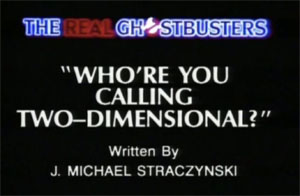 The group lands in a universe where there is no sky nor ground – essentially, a blank slate. Charging past them on the run comes one of Fleischman’s creations, Conqueror Duck – in the flesh, so to speak. He is soon followed by one Ricky Roach, driving a miniature jalopy, and asking which way the Duck went. I never followed this series, so I am unfamiliar with the names of the respective humans, but one principal member who gets virtually all the laughs is voiced by Lorenzo Music (heard on “Rhoda” and also the voice of Garfield). We’ll call him Music for reference here. Music jumps in startlement at the sight of a talking roach – and keeps floating straight up. He is now somewhat willing to believe the gang’s theory that they have fallen into a cartoon universe, where only cartoon logic prevails, but asks how he is supposed to get down. Another of the group shouts to him, “Think of a cliff.” Music does – and suddenly, an overhanging cliff materializes above his head, designed in the same manner as one for Wile E. Coyote, for him to smack his head into. Music falls, and, to complete the parallel to Wile E.’s universe, a portion of canyon floor appears under hum, for him to crash down upon. Music asks, “You couldn’t say, ‘think of a pillow’, right ?” The group trudges on aimlessly, until one of them asks. if this is a cartoon, where’s the audience? “Over there, I guess”, surmises the inventive genius among them, pointing to a small transparent gray square of glass floating in air, off to one side. The question-asker steps up to the glass, knocks on it from the inside, then presses his face to it, calling. “Hello, hello!” When he returns to the group, they ask him what happened. “They changed channels”, is the reply.
The group lands in a universe where there is no sky nor ground – essentially, a blank slate. Charging past them on the run comes one of Fleischman’s creations, Conqueror Duck – in the flesh, so to speak. He is soon followed by one Ricky Roach, driving a miniature jalopy, and asking which way the Duck went. I never followed this series, so I am unfamiliar with the names of the respective humans, but one principal member who gets virtually all the laughs is voiced by Lorenzo Music (heard on “Rhoda” and also the voice of Garfield). We’ll call him Music for reference here. Music jumps in startlement at the sight of a talking roach – and keeps floating straight up. He is now somewhat willing to believe the gang’s theory that they have fallen into a cartoon universe, where only cartoon logic prevails, but asks how he is supposed to get down. Another of the group shouts to him, “Think of a cliff.” Music does – and suddenly, an overhanging cliff materializes above his head, designed in the same manner as one for Wile E. Coyote, for him to smack his head into. Music falls, and, to complete the parallel to Wile E.’s universe, a portion of canyon floor appears under hum, for him to crash down upon. Music asks, “You couldn’t say, ‘think of a pillow’, right ?” The group trudges on aimlessly, until one of them asks. if this is a cartoon, where’s the audience? “Over there, I guess”, surmises the inventive genius among them, pointing to a small transparent gray square of glass floating in air, off to one side. The question-asker steps up to the glass, knocks on it from the inside, then presses his face to it, calling. “Hello, hello!” When he returns to the group, they ask him what happened. “They changed channels”, is the reply.
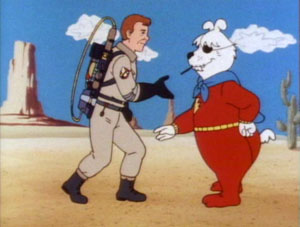 A cry for help is heard, and with no explanation, backgrounds appear in a mecho-urban style, which the boys run into. Within a large mechanized factory set, they find a surprise, Peering through a window, they observe none other than Walt Fleischman himself, still alive and not aged a day, but standing with his hands bound, before a wolf-like character, who we come to learn is named Winchester Wolf – a personification of evil. In Walt’s conversation with Winchester, we discover that Walt has been being tormented for 40 years, having to endure every foul twist of fate he ever had his characters endure back in his cartoons. Currently, Winchester is keeping score on the 4,553 times Walt had characters fall through trap door – leaving Walt to experience only 2,057 more painful falls himself. The Ghostbusters decide to break Fleischman loose, presuming that if this is a world of his creation, he may be able to lead them to an exit. They bust in the door, as Music calls out, “Show’s over. You’ve just been cancelled.” What works for Walt works for the Ghostbusters, as Winchester opens another trap door under them, dropping them out into a miniature glass cube staged inside like a barren desert. One of the gang wonders where the good guys are, and recalls Walt’s favorite hero character, Dopey Dog (a possible backhanded reference to Super Goof). Recalling a chant from the cartoons by which one was to summon the mighty dog, the call is indeed answered by the mutt in red leotards (an outfit again resembling Super Goof’s long Johns). It turns out, however, that Dopey is merely a cartoon character playing a super hero, and a far cry from the makings of a real super hero at heart. However, he is able to recount Walt’s history. Walt strove for the most realistic cartoon possible – but was never satisfied. Somehow, one night, he willed his camera equipment into transforming his characters into living reality, so that he no longer had to draw them – only needing to film them. Then, he made his mistake by creating Winchester. Winchester grew too powerful to control, and one night when Walt let his defenses down, Winchester opened the portal door in Walt’s office, sucking him into the cartoon world. Walt has never aged since – as no one grows old in animated cartoons. Winchester observes the conversation within the cube, and believes that Dopey may be giving them too much information helpful to rescuing Walt or finding an exit, so sends Conqueror Duck to run interference. “Winchester wants to know what you’re doing on that cliff”, the duck asks. And suddenly, a towering cliff rises from the desert floor, with three of the Ghostbusters hanging onto its sides, hundreds of feet in the air. Conqueror Duck yields to the Ghostbusters’ calls to get them down, by chopping the cliff apart at its base, toppling it like a tree. Dopey Dog advises the remaining Ghostbuster that the only way to save his friends is to stretch a background of a nearby lake, by grabbing the edge of the water and pulling. Unbelievable – yet it works, soaking the falling Ghostbusters, but saving their necks. Dopey advises the drenched trio to merely walk out of frame, then a moment later walk back in – at which point, they are all fully dry. “Works every time.”, says Dopey.
A cry for help is heard, and with no explanation, backgrounds appear in a mecho-urban style, which the boys run into. Within a large mechanized factory set, they find a surprise, Peering through a window, they observe none other than Walt Fleischman himself, still alive and not aged a day, but standing with his hands bound, before a wolf-like character, who we come to learn is named Winchester Wolf – a personification of evil. In Walt’s conversation with Winchester, we discover that Walt has been being tormented for 40 years, having to endure every foul twist of fate he ever had his characters endure back in his cartoons. Currently, Winchester is keeping score on the 4,553 times Walt had characters fall through trap door – leaving Walt to experience only 2,057 more painful falls himself. The Ghostbusters decide to break Fleischman loose, presuming that if this is a world of his creation, he may be able to lead them to an exit. They bust in the door, as Music calls out, “Show’s over. You’ve just been cancelled.” What works for Walt works for the Ghostbusters, as Winchester opens another trap door under them, dropping them out into a miniature glass cube staged inside like a barren desert. One of the gang wonders where the good guys are, and recalls Walt’s favorite hero character, Dopey Dog (a possible backhanded reference to Super Goof). Recalling a chant from the cartoons by which one was to summon the mighty dog, the call is indeed answered by the mutt in red leotards (an outfit again resembling Super Goof’s long Johns). It turns out, however, that Dopey is merely a cartoon character playing a super hero, and a far cry from the makings of a real super hero at heart. However, he is able to recount Walt’s history. Walt strove for the most realistic cartoon possible – but was never satisfied. Somehow, one night, he willed his camera equipment into transforming his characters into living reality, so that he no longer had to draw them – only needing to film them. Then, he made his mistake by creating Winchester. Winchester grew too powerful to control, and one night when Walt let his defenses down, Winchester opened the portal door in Walt’s office, sucking him into the cartoon world. Walt has never aged since – as no one grows old in animated cartoons. Winchester observes the conversation within the cube, and believes that Dopey may be giving them too much information helpful to rescuing Walt or finding an exit, so sends Conqueror Duck to run interference. “Winchester wants to know what you’re doing on that cliff”, the duck asks. And suddenly, a towering cliff rises from the desert floor, with three of the Ghostbusters hanging onto its sides, hundreds of feet in the air. Conqueror Duck yields to the Ghostbusters’ calls to get them down, by chopping the cliff apart at its base, toppling it like a tree. Dopey Dog advises the remaining Ghostbuster that the only way to save his friends is to stretch a background of a nearby lake, by grabbing the edge of the water and pulling. Unbelievable – yet it works, soaking the falling Ghostbusters, but saving their necks. Dopey advises the drenched trio to merely walk out of frame, then a moment later walk back in – at which point, they are all fully dry. “Works every time.”, says Dopey.
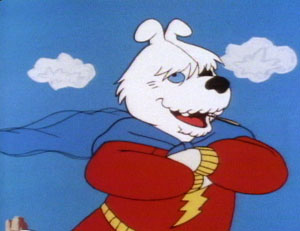 Dopey ultimately leads the gang to the edge of cartoon world, where Winchester for reasons unknown has moved his operations, having Walt tied to a stake, taking pies in the face to equal the score of how many times his characters endured the humiliation. On the way to the site, Dopey rounds up every friendly animal who was on the good guys’ side in the old cartoons. They rise en masse upon the top of a ridge, and charge down at Winchester’s group. Gophers rise from the ground to gnaw at and sever Walt’s bonds from the stake. Dopey engages in some swordplay with Winchester, while the Ghostbusters hustle Walt to one side of the layout. Winchester asks Dopey what good taking Walt away will do, as there’s nowhere in cartoon world Winchester can’t reach him. But Dopey has a plan. “NOW, my friends”, he calls to the other animals. They begin sticking sharp objects into the background, and tugging at the edge of the frame area – and begin ripping the edge of the film on which they exist apart. The film breaks, and the portion on which the Ghostbusters and Walt stand rises upwards into a black, space-like void toward a giant sprocket-wheel. “Beyond those sprockets is home”, calls out Dopey, telling them not to worry about himself or the others and don’t look back. Winchester leaps into the space void, attempting to follow, pleading to Walt that he can’t exist without him, and that they had a contract. But Walt and the boys clear the sprocket wheel, and crash through the rematerializing portal door, back into Walt’s office. The door disappears again, hopefully this time for good. The caretaker enters to find Walt very much alive and well. Walt tells the boys he doesn’t know how to thank them, and the biggest fan of toons among them proposes a suggestion for payment for their services. He receives it on the mail a short time later, much to the consternation of the others – a life-size Dopey Dog doll. (Left unanswered: Will Walt go back to making cartoons the old-fashioned way, to keep the cartoon universe from ever existing again? Or is enough enough for involvement with the industry? Well, Roger Rabbit WAS right around the corner…)
Dopey ultimately leads the gang to the edge of cartoon world, where Winchester for reasons unknown has moved his operations, having Walt tied to a stake, taking pies in the face to equal the score of how many times his characters endured the humiliation. On the way to the site, Dopey rounds up every friendly animal who was on the good guys’ side in the old cartoons. They rise en masse upon the top of a ridge, and charge down at Winchester’s group. Gophers rise from the ground to gnaw at and sever Walt’s bonds from the stake. Dopey engages in some swordplay with Winchester, while the Ghostbusters hustle Walt to one side of the layout. Winchester asks Dopey what good taking Walt away will do, as there’s nowhere in cartoon world Winchester can’t reach him. But Dopey has a plan. “NOW, my friends”, he calls to the other animals. They begin sticking sharp objects into the background, and tugging at the edge of the frame area – and begin ripping the edge of the film on which they exist apart. The film breaks, and the portion on which the Ghostbusters and Walt stand rises upwards into a black, space-like void toward a giant sprocket-wheel. “Beyond those sprockets is home”, calls out Dopey, telling them not to worry about himself or the others and don’t look back. Winchester leaps into the space void, attempting to follow, pleading to Walt that he can’t exist without him, and that they had a contract. But Walt and the boys clear the sprocket wheel, and crash through the rematerializing portal door, back into Walt’s office. The door disappears again, hopefully this time for good. The caretaker enters to find Walt very much alive and well. Walt tells the boys he doesn’t know how to thank them, and the biggest fan of toons among them proposes a suggestion for payment for their services. He receives it on the mail a short time later, much to the consternation of the others – a life-size Dopey Dog doll. (Left unanswered: Will Walt go back to making cartoons the old-fashioned way, to keep the cartoon universe from ever existing again? Or is enough enough for involvement with the industry? Well, Roger Rabbit WAS right around the corner…)
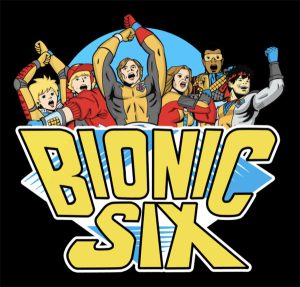 That’s All, Folks (MCA/Universal, Bionic Six – 11/12/87) – Another series I never followed, but which chose to end its run with an unusual finale bang. Members of the Bionic Six family attend an awards benefit, where a classic cartoon by legendary director Flub Fleming (an obvious attempt to spoof the name of Friz Freleng) is being screened. The cartoon features a hunter who strongly resembles Egghead, but talks with a profound lisp instead of a problem with pronouncing “R”s. He is hunting a skunk, who in appearance is Pepe Le Pew but who acts more like Bugs Bunny. The cartoon uses predictable toony gags and is reasonably-well animated for television standards. At the conclusion of the screening, a fat bejeweled Madame of Ceremonies invites Flub in person out on the stage, to receive a lifetime achievement award after 50 years of production and upon his retirement. But Flub does not accept the award gracefully, revealing that he did not retire, and that the Madame had his show cancelled. The Madame begins to relate demographic statistics in defense, declaring Flub’s work hopelessly outdated and a product of its day, and not what the modern viewer wants or needs. “Funny is funny”, insists Flub, declaring that those like her don’t know what it means to make children laugh anymore. He demonstrates what cartoon comedy is all about, by plastering the Madame with a pie in the face, then declares he is leaving for a place where children have something to laugh at. Right onstage, he unzips what appears to be a wormhole, walks into it, and disappears from existence.
That’s All, Folks (MCA/Universal, Bionic Six – 11/12/87) – Another series I never followed, but which chose to end its run with an unusual finale bang. Members of the Bionic Six family attend an awards benefit, where a classic cartoon by legendary director Flub Fleming (an obvious attempt to spoof the name of Friz Freleng) is being screened. The cartoon features a hunter who strongly resembles Egghead, but talks with a profound lisp instead of a problem with pronouncing “R”s. He is hunting a skunk, who in appearance is Pepe Le Pew but who acts more like Bugs Bunny. The cartoon uses predictable toony gags and is reasonably-well animated for television standards. At the conclusion of the screening, a fat bejeweled Madame of Ceremonies invites Flub in person out on the stage, to receive a lifetime achievement award after 50 years of production and upon his retirement. But Flub does not accept the award gracefully, revealing that he did not retire, and that the Madame had his show cancelled. The Madame begins to relate demographic statistics in defense, declaring Flub’s work hopelessly outdated and a product of its day, and not what the modern viewer wants or needs. “Funny is funny”, insists Flub, declaring that those like her don’t know what it means to make children laugh anymore. He demonstrates what cartoon comedy is all about, by plastering the Madame with a pie in the face, then declares he is leaving for a place where children have something to laugh at. Right onstage, he unzips what appears to be a wormhole, walks into it, and disappears from existence.
The series apparently features a professor/scientist type who helps the Bionic Six, and his evil brother Scarab, who is the Six’s nemesis. While the good professor conducts a computer scan to locate the whereabouts of any inter-dimensional wormholes in the vicinity, a dum-dum henchman of Scarab’s works on repairing Scarab’s own computer, but operates under the delusion that he is repairing a TV set. The result is some crossed wires that hack into Scarab’s computer, releasing to Scarab the same report on the location of the wormhole at the same time as the Professor receives it – located at the home of Flub Fleming at 2222 Clampett Drive. All forces arrive at the location at the same time, and a game of grab and keep-away ensues over a gun-like ray device intended to capture the wormhole. In the confusion, the gun falls into the hands of Scarab’s sergeant-at-arms. The enterprising sergeant sees a once-in-a-lifetime opportunity for self-advancement, and uses the device to open the wormhole to full width. Three of the Bionic Six, and Scarab and two of his henchmen, are sucked into the portal, and the traitorous sergeant uses the gun to close up the portal again, trapping his former boss into another dimension.
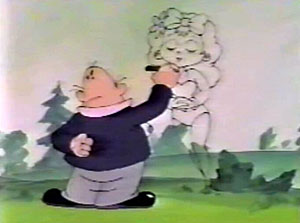 All who passed through the portal change in appearance, transforming into cartoon characters in the mold of a Flub Fleming cartoon. They immediately begin to encounter others of Fleming’s cartoon world. The three members of the Six plummet toward the ground from the sky, but without warning have the brakes slammed on their fall, to allow a random character to saunter past them below at an unhurried gait – then complete their landing with full force into the hard ground. Scarab’s group is attacked and chased by some random characters, until Scarab’s dumb henchman declares that he doesn’t think they’re being chased anymore. Why? The three have run off a cliff, and stay in mid-air until they look down. The Bionic Three decide to focus their attention on finding whether Fleming is here, in hopes he can direct them to the way out. Scarab’s group hopes to find Fleming first, then leave the Three trapped in this whacked-out world forever.
All who passed through the portal change in appearance, transforming into cartoon characters in the mold of a Flub Fleming cartoon. They immediately begin to encounter others of Fleming’s cartoon world. The three members of the Six plummet toward the ground from the sky, but without warning have the brakes slammed on their fall, to allow a random character to saunter past them below at an unhurried gait – then complete their landing with full force into the hard ground. Scarab’s group is attacked and chased by some random characters, until Scarab’s dumb henchman declares that he doesn’t think they’re being chased anymore. Why? The three have run off a cliff, and stay in mid-air until they look down. The Bionic Three decide to focus their attention on finding whether Fleming is here, in hopes he can direct them to the way out. Scarab’s group hopes to find Fleming first, then leave the Three trapped in this whacked-out world forever.
 One of the Three begins to complain that he’s pretty sure they’ve passed the same repeating background about ten times. Another of them refers to this whole place as upside down. A duck character waddles across the sky – walking upside down – but shouts at the Three “Aw, sez you!” Upon his protest, the background pivots, sky becomes ground, and the Three find themselves inverted and in mid-air, falling on their backs onto the ground. The bird is yet another of Flub’s creations, Chucky Duck. “My card”, says Chucky, passing to one of our heroes a Joker out of a poker deck. The Joker figure, a costumed duplicate of Chucky, emerges from the card to plant a juicy kiss upon the boy’s lips, then shakes hands with the real Chucky. A girl member of the Three thinks Chucky is cute – and is immediately wood by Chucky in mock-French a la Pepe Le Pew. “We will make beautiful music together”, coos Chucky – then breaks into a trombone solo and impromptu vocal on “Be Kind To Your Web-Footed Friends”. They stop him to ask for information. As if suddenly undergoing the third degree, Chucky “cracks” spilling everything he knows about an unknown “zoo job” in rapid-fire morphs into animals of every species. One of the Three believes that Chucky is “ducking the question.” They finally get through to Chucky that they seek to find Flub. Chucky states that his address is “right on the tip of my tongue”, then opens his mouth to reveal an address book resting precisely of the tip of such appendage.
One of the Three begins to complain that he’s pretty sure they’ve passed the same repeating background about ten times. Another of them refers to this whole place as upside down. A duck character waddles across the sky – walking upside down – but shouts at the Three “Aw, sez you!” Upon his protest, the background pivots, sky becomes ground, and the Three find themselves inverted and in mid-air, falling on their backs onto the ground. The bird is yet another of Flub’s creations, Chucky Duck. “My card”, says Chucky, passing to one of our heroes a Joker out of a poker deck. The Joker figure, a costumed duplicate of Chucky, emerges from the card to plant a juicy kiss upon the boy’s lips, then shakes hands with the real Chucky. A girl member of the Three thinks Chucky is cute – and is immediately wood by Chucky in mock-French a la Pepe Le Pew. “We will make beautiful music together”, coos Chucky – then breaks into a trombone solo and impromptu vocal on “Be Kind To Your Web-Footed Friends”. They stop him to ask for information. As if suddenly undergoing the third degree, Chucky “cracks” spilling everything he knows about an unknown “zoo job” in rapid-fire morphs into animals of every species. One of the Three believes that Chucky is “ducking the question.” They finally get through to Chucky that they seek to find Flub. Chucky states that his address is “right on the tip of my tongue”, then opens his mouth to reveal an address book resting precisely of the tip of such appendage.
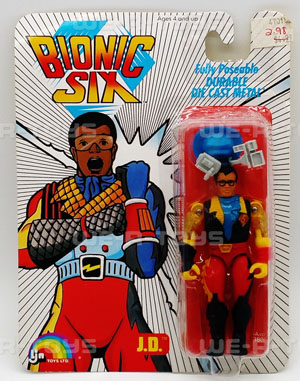 Meanwhile, the Scarab team has stumbled upon the same address. Inside, they find Fleming’s skunk character, who mimics a routine used by Daffy Duck in “Tom Turk and Daffy” and by Bugs Bunny in “Racketeer Rabbit”, claiming that an unspecified “Them” are coming, and stuffing the bad guts into all kinds of hiding places into which they are too large to fit. The real Fleming is finally located by the Three, merely wandering casually about cartoon land, using his pencil to draw a Betty Boop-style girl to give him a kiss. Flub is surprised to find the Three in his world, and some mutual explaining takes place. Similar to the Walt Fleischman story, Flub claims to have stumbled upon this world years ago, where his mere drawings or thoughts would spring to life, and comes to it whenever he wants to create, or to merely see his ideas in action, the way they were intended to be seen – uninterrupted and funny. Their conversation is brief, as Scarab’s group have escaped the skunk, and are close behind. Scarab’s dum henchman makes a suggestion that his boss should pick up some weaponry. Scarab sarcastically responds, as if an Acme delivery truck would just come along and drop a crate of same in their laps. Sure enough, one such truck does exactly that, dropping off a large gun that sucks up whole backgrounds and characters like a vacuum. Scarab has no idea what it is, but he likes it. Backgrounds disappear from behind Flub and the good guys. In a scene that even the characters admit “makes no sense”, the weapon somehow changes hands, and Scarab and his boys end up sucked into it themselves. Flub proposes that it’s time that all of them went home, and we discover that he has free access in and out of this world, by merely drawing a wormhole to create his own exit. The somehow all-knowing Flub deposits everyone in a place where the Three can be reunited with the rest of their family – inside the underwater lair of Scarab, where the remaining three members of the family have been battling Scarab’s sergeant to prevent him from permanently destroying the wormhole. Rather than continue the battle, Scarab, now released from the toon gun, closes a wall between the Bionic Six and his own boys, closing himself inside a large escape pod, to sail away to fight another day. Of course, the traitor sergeant can only say aloud, “Am I gonna get it.”
Meanwhile, the Scarab team has stumbled upon the same address. Inside, they find Fleming’s skunk character, who mimics a routine used by Daffy Duck in “Tom Turk and Daffy” and by Bugs Bunny in “Racketeer Rabbit”, claiming that an unspecified “Them” are coming, and stuffing the bad guts into all kinds of hiding places into which they are too large to fit. The real Fleming is finally located by the Three, merely wandering casually about cartoon land, using his pencil to draw a Betty Boop-style girl to give him a kiss. Flub is surprised to find the Three in his world, and some mutual explaining takes place. Similar to the Walt Fleischman story, Flub claims to have stumbled upon this world years ago, where his mere drawings or thoughts would spring to life, and comes to it whenever he wants to create, or to merely see his ideas in action, the way they were intended to be seen – uninterrupted and funny. Their conversation is brief, as Scarab’s group have escaped the skunk, and are close behind. Scarab’s dum henchman makes a suggestion that his boss should pick up some weaponry. Scarab sarcastically responds, as if an Acme delivery truck would just come along and drop a crate of same in their laps. Sure enough, one such truck does exactly that, dropping off a large gun that sucks up whole backgrounds and characters like a vacuum. Scarab has no idea what it is, but he likes it. Backgrounds disappear from behind Flub and the good guys. In a scene that even the characters admit “makes no sense”, the weapon somehow changes hands, and Scarab and his boys end up sucked into it themselves. Flub proposes that it’s time that all of them went home, and we discover that he has free access in and out of this world, by merely drawing a wormhole to create his own exit. The somehow all-knowing Flub deposits everyone in a place where the Three can be reunited with the rest of their family – inside the underwater lair of Scarab, where the remaining three members of the family have been battling Scarab’s sergeant to prevent him from permanently destroying the wormhole. Rather than continue the battle, Scarab, now released from the toon gun, closes a wall between the Bionic Six and his own boys, closing himself inside a large escape pod, to sail away to fight another day. Of course, the traitor sergeant can only say aloud, “Am I gonna get it.”
A final scene has the Bionic family sitting around the house with the television running on a Saturday morning. It turns out there was such a fuss about Flub’s disappearance, that upon his return to the real world, his cartoons were put back on the air, with his old familiar characters visible in action on the screen. One of the Six makes an astute observation. “Those characters in that crazy world didn’t know they were cartoons. They were real to themselves. For all we know, WE’re not real. We could be just characters on a cartoon show.” After a momentary pause, the entire family responds in unison. “Naaaah!” The camera pulls back from the exterior of the family home, as a series of four signs are held in front of the camera by toon hands. “The End!” “Good-Bye!” “Adios!” “Fade out, already! (Sheesh!)”
• A very dimensionally squashed and angled copy of “That’s All Folks” is on Dailymotion.
NEXT WEEK: Steven Spielberg sets the animation world on its rabbit’s ear.